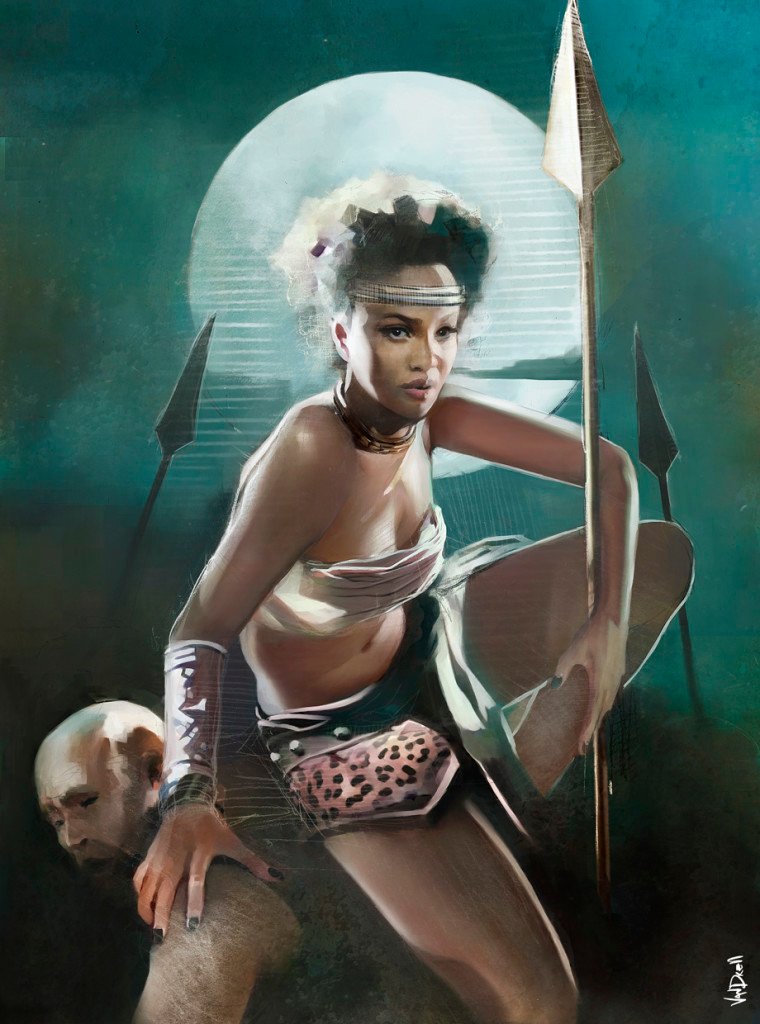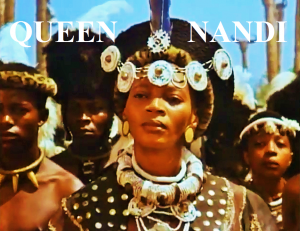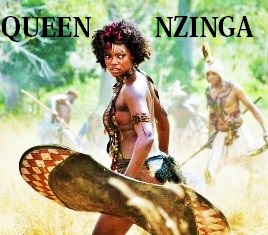Queen Nzinga of Ndongo and Matamba (1583-1663) was an Angolan Queen. She was the daughter of a King , and was exposed to war and politics at an early age. Queen Nzinga 2 sisters were some of her war-lords and she had women in her army. When the Portuguese built a fort on her land, she led a diplomatic party in name of her ruling brother, to try and get them to withdraw.
Statue of Nzinga of Ndongo and Matamba in Luanda, Angola.
She also asked for several African slaves captured by the Portuguese to be returned. Despite the Portuguese attempts of outsmarting her during the negotiations, she proved a worthy diplomat, and made the Portuguese sign a treaty accepting all of her conditions. However, the Portuguese did not honor the treaty, and Nzinga’s brother killed himself in despair. She went on to succeed him, and made contact with the Dutch, creating a formal alliance against the Portuguese.

Queen Nzinga T.V. series above
She fought several battles, having an initial victory followed by a tragic defeat. However, with the arrival of Dutch reinforcements placed under her command, she destroyed the Portuguese army and laid siege to the colonial capital. However, the Portuguese were later able to retake the city with Brazilian forces, forcing her to retreat.

Statue of Nzinga of Ndongo and Matamba in Luanda, Angola.
She carried on her resistance until she was over 60 years old, causing much trouble and despair for the Portuguese. Eventually, she signed a leave treaty, and devoted herself to rebuilding her damaged nation, also resettling former slaves. She would go on to become a major Angolan hero after her death, being praised by Africans and Europeans alike for her military prowess, diplomatic skill, great intelligence, and strong will.
www.historyisfun.org/sites/discovering-jamestown/imagegalleries/Africans/album/slides/Queen
Angola is a southern African nation whose varied terrain encompasses tropical Atlantic beaches, a labyrinthine system of rivers and Sub-Saharan desert that extends across the border into Namibia.
The country’s colonial history is reflected in its Portuguese-influenced cuisine and its landmarks including Fortaleza de São Miguel, built by the Portuguese in 1576 to defend the capital, Luanda.
Capital: Luanda
Population: 21.47 million (2013) World Bank
Currency: Angolan kwanza
Continent: Africa
GDP per capita: 5,783.37 USD (2013) World Bank
Official language: Portuguese
Baia de Luanda financial center
Luanda, formerly named São Paulo da Assunção de Loanda, is the capital city of Angola, and the country’s most populous and important city, primary port and major industrial, cultural and urban centre.


Art by David LeNormand
Queen Nzinga declared all territory of Angola a free country and offered refuge to escaped slaves.













 Fascinating movie spans the globe to reveal recent discoveries about water, the most amazing yet least studied substance in the world. Witness as researchers, scientists, philosophers and theologians try to understand this unique liquid and all [...]
Fascinating movie spans the globe to reveal recent discoveries about water, the most amazing yet least studied substance in the world. Witness as researchers, scientists, philosophers and theologians try to understand this unique liquid and all [...] 

























































 Take care of your body, it's the only
Take care of your body, it's the only








































